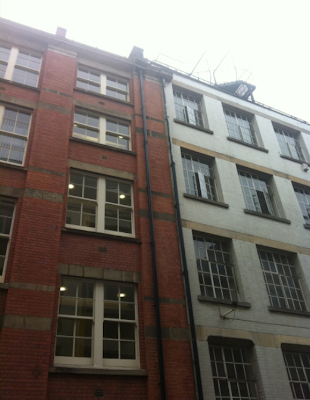"Please remember the Garland"
"In the southern counties of England, it often comes to pass on May morning that the gentlefolk who are still in their beds, or in the act of dressing, or even breakfasting, according to the time-table of the particular house, become aware of children's voices out of doors. And, if they look, of the children themselves, wearing and carrying floral decorations. They will hear, spoken or chanted, over and over again: -
First of May
Is garland day,
Please to remember the garland.
When the words reach the ear as -
First of My
Is garland dy,
 |
| Garland Day in the garden at Sandhouse, Witley from The Ailing Countryside and prescriptions for some forthcoming physic by "Home Counties" c. 1910 |
There needs no milestone to convince the listener of being within forty miles of Hyde Park Corner (- nb. the 40 miles to Hyde Park Corner milestone stands in Haslemere High Street). If the district were further removed from that centre of culture, it is quite possible the little chant will be followed by the beautiful May-day song:
I've been a -wandering all this night
And some of this day,
And now returning home again,
I've brought you a garland gay.
A garland gay I've brought you here,
And at your door I stand.
'Tis nothing but a sprout,
But it's well budded out
By the work of our Lord's hand.
Here and there the gentlefolk are dimly conscious that the little group they are looking upon is the very last of a vanishing picturesque past, and, in a sudden stir of pity and pleasure, send out largess. More often the children are hardly noticed, and if it were not for the servants (who always find something for these and for carol-singers and organ-grinders too) they would clatter away no heavier by a single penny or bun.
 |
| detail from embroidered panel, designed by Godfrey Blount, 1896, V&A Museum |
And yet, as sheer matter of fact, these children are the faithful priests of an ancient and universal religion, and their weak shoulders, alone of all to-day, uphold the age-long tradition; of which they know no more than the eternal human heart in their breasts and their unlettered mothers can tell them. They come from far, and are just the remnant of a great company who have dropped off by the way: whose very names they have forgotten, although they would know and welcome them did they ever meet them again. They do not know that they are one of the multitude in many lands and ages, but so it is. The fellows of these little people in pinafores and clumsy boots, sang love-songs of rapturous welcome to the swallow two thousand years ago in Greece. And to-day, over the same ground, they pass in little companies, carrying a wooden swallow from door to door, asking gifts of fruit and cheese from those who welcome with them this harbinger of fruitful days, and singing.
She is here, she is here,
The swallow that brings us the beautiful year;
Open wide the door,
We are children again, we are old no more.
They broke the green boughs in the woods of Roman Britain and decked their homes with them for the Floralia, the festival which the Romans brought hither along with sterner things; and they danced around a flowery pole set up in honour of the sweet Goddess of flowers and fruitful promise."










